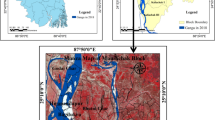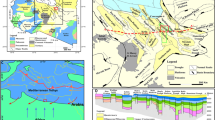Abstract
The north-south trending Kullu valley between Rohtang in the north and Hansu in the south is a wide and open valley filled with Quaternary sediments along the main course of the Beas River. The valley in the middle is drained by the Beas River and numerous tributaries join it laterally. The tributary channels have deposited large alluvial fans at their mouths which form three distinct levels. The Beas River has deposited alluvial terraces, which are very distinct towards the lower reaches and form three to four levels. The upper slopes and high altitudinal areas are covered with periglacial and glacial deposits. The terrace, fan and hill slopes have provided an ideal geoenvironment for human activities including agriculture, horticulture, dense settlements and other civil establishments.
The Kullu Valley is prone to various natural hazards, flash floods and cloudbursts that are very common in this valley due to its peculiar geomorphic condition, high relief of peripheral ridges and impact of monsoon winds. The studies carried out so far indicate that the losses caused by these phenomena both in terms of life and property are mainly due to unwise human interaction with the geoenvironment of the area. The paper gives an overview of the geoenvironmental status of the Kullu Valley and suggests the necessity of undertaking further detailed studies including resource mapping for balanced development of the area.
Similar content being viewed by others
References
Bartarya S.K., Virdi N.S. and Sah M.P. 1996. Landslide hazards: some case studies from the Satluj valley, Himachal Pradesh. Himalayan Geology 17: 193–207.
BHAGAT R.M., KALIA V., SOOD C., MOOL P.K., BAJARACHARYA S.R., SHAKYA K., DANGOL G.S. 2004. Himachal Pradesh Himalaya, India: inventory of glaciers, glacial lakes and the identification of potential glacial lake outburst floods (GLOFs) affected by global warming (draft version) in CD form. ICIMOD, Kathmandu.
Bhan S.C., Paul S. and Kharbanda K.L. 2004. Cloudburst in Himachal Pradesh. Mausam (IMD, N. Delhi, Publication) 55(4): 712–713.
BBMB. 2003. Meteorological data, Pandoh
DAVIS J.L. 1969. Landforms of Cold Climates. The M.I.T. Press, Massachusetts, Pp 200.
Gupta V., Bartarya S.K., Virdi N.S. and Sah M.P. 1995. Climatic zones, vis-à-vis, landslide activity along the Satluj valley in the Higher and Lesser Himalaya of Himachal Pradesh. Proceedings of ISRS Silver Jubilee Symposium, pp 80–86.
Hewitt K. 1993. Torrential rains in central Karakoram, 9–10 September 1992. geomorphological impacts and implications for climate change. Mountain Research and Development 13: 371–375.
Kuhle, M. 1986. The upper limit of glaciation in the Himalayas. GeoJournal 13(4): 331–346.
Mazari R.K and Sah M.P. 2004. Pulia Nal cloudburst of July 16, 2003, District Kullu, Himachal Pradesh: lesson for policy implementation. Himalayan Geology 25(2): 153–161.
Mazari R.K., Sah M.P. and Bartarya S.K. 2003. Policy and mitigation strategy of landslides in Himalayan roads. In Seminar Souvenir ‘National Seminar on Disaster Management with SpecialReference to Landslide and Avalanches’. New Delhi 187–197.
Pandey A.K. Virdi N.S. and Gairola V.K. 2003. Evolution of structural fabric and deformation events in the Kulu-Rampur and Larji window zones, NW Himalaya, India. Himalayan Geology 24(1): 1–21.
Paul S.K., Bartarya S.K., Rautala P. and Mahajan A.K. 2000. Catastrophic mass movement of 1998 monsoon at Malpa in Kali valley, Kumaun Himalaya (India). Geomorphology, 35: 169–180.
Sah M.P., Asthana A.K.L. and Rawat B.S. 2003. Cloudburst of August 10, 2002 and related landslides and debris flows around Budha Kedar (Thati Kathur) in Balganga valley, District Tehri. Himalayan Geology 24(2): 87–101.
Sah M.P. and Bist KS. 1998. Catastrophic mass movement of August 1998 in Okhimath area, Garhwal Himalaya. Proc. Intl. Workshop on Landslide Hazard & Risk Assessment and Damage Control for Sustainable Development, New Delhi, 259–282.
Sah M.P. and Mazari R.K. 1998. Anthropogenically accelerated mass movement in the Kullu valley, Himachal Pradesh, India. Geomorphology 26: 123–138.
Sah M.P. and Mazari R.K. 2004. WIHG Annual Report 2003 ∼ 2004: 16–17.
Sah M.P., Virdi N.S. and Bartarya S.K. 1996. Slope failure and damming of river channels: Some example from Satluj valley, Himachal Pradesh. Himalayan Geology 17(1&2): 183–191.
Shankar R. and Dua K.J.S. 1978. On the existence of a tear fault along upper Beas valley, District Kulu, Himachal Pradesh, and its bearing on the thermal activity. Himalayan. Geology 8(1): 466–472.
Singh G. and Agrawal D.P. 1976. Radiocarbon evidence for deglaciation in northwestern Himalaya, India, Nature 260(5548): 232.
Singh T.V. 1989. The Kullu valley — Impact of Tourist Development in the Mountain Areas. Himalayan Books, New Delhi, Pp 214.
Shroder J.F. (Jr) and Bishop P.B. 1998. Mass movement in the Himalaya: new insights and research directions. Geomorphology 26: 13–35.
SRIKANTIA S.V. and BHARGAVA O.N. 1998. Geology of Himachal Pradesh. Geological Society of India, Pp406.
Statistical Abstracts of Kullu District. 1988, 1991 and 2001. Issued by Directorate of Economics and Statistics Government of Himachal Pradesh, Shimla.
Valdiya K.S. 1985. Accelerated erosion and landslide-prone zones in the Central Himalayan region. In: Singh, J.S. (ed.), Environmental Regeneration in the Himalaya: Concepts and Strategies. Central Himalayan Environmental Association. Gyanodaya Prakashan, Nainital, Pp 12–38.
WALIA J.S. 1994. Revised Working Plan for the forests of Kullu and Parbati Forest Division. Forest Department, Govt. of Himachal Pradesh.
Author information
Authors and Affiliations
Corresponding author
Rights and permissions
About this article
Cite this article
Sah, M.P., Mazari, R.K. An overview of the geoenvironmental status of the Kullu Valley, Himachal Pradesh, India. J. Mt. Sci. 4, 003–023 (2007). https://doi.org/10.1007/s11629-007-0003-x
Received:
Accepted:
Issue Date:
DOI: https://doi.org/10.1007/s11629-007-0003-x




